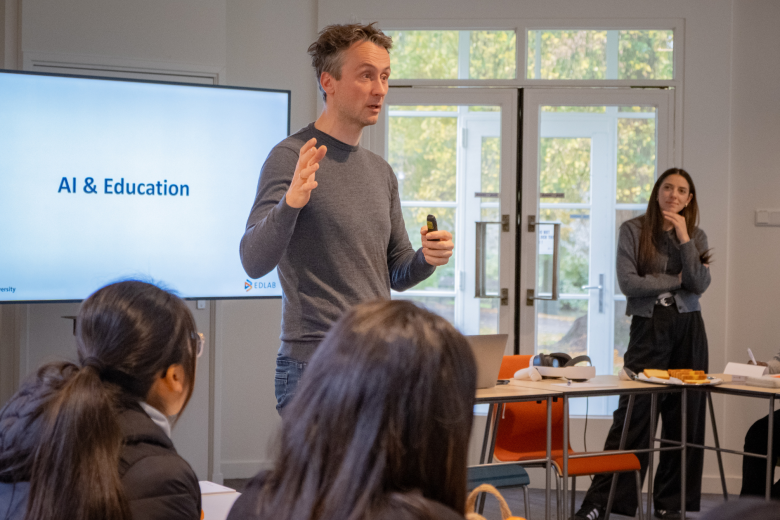Education That Moves You: Sources
Would you like to know more about the sources that were used for this research?
We have compiled an overview of the references.
Biswas, A., Oh, P., Faulkner, G., Bajaj, R., Silver, M., Mitchell, M., & Alter, D. (2015). Sedentary Time and Its Association With Risk for Disease Incidence, Mortality, and Hospitalization in Adults. Annals Of Internal Medicine, 162(2), 123. doi:10.7326/m14-1651
Brown, W., Williams, L., Ford, J., Ball, K., & Dobson, A. (2005). Identifying the Energy Gap: Magnitude and Determinants of 5-Year Weight Gain in Midage Women. Obesity Research, 13(8), 1431-1441. doi:10.1038/oby.2005.173
Davis, K. G., Kotowski, S. E., Sharma, B., Herrmann, D., & Krishnan, A. P. (2009). Combating the effects of sedentary Work: postural Variability reduces musculoskeletal discomfort. In Proceedings of the Human Factors and Ergonomics Society Annual Meeting (Vol. 53, No. 14, pp. 884-886). Sage Publications.
Ekelund, U., Steene-Johannessen, J., Brown, W. J., Fagerland, M. W., Owen, N., Powell, K. E., Bauman, Lee, I. (2016). Does physical activity attenuate, or even eliminate, the detrimental association of sitting time with mortality? A harmonised meta-analysis of data from more than 1 million men and women. The Lancet, 388(10051), 1302-1310.
Garrett, G., Benden, M., Mehta, R., Pickens, A., Peres, C., & Zhao, H. (2015). Call Center Productivity Over 6 Months Following a Standing Desk Intervention. IIE Transactions on Occupational Ergonomics and Human Factors, (just-accepted), 00-00.
Grunseit, A., Chau, J., van der Ploeg, H., & Bauman, A. (2013). “Thinking on your feet”: A qualitative evaluation of sit-stand desks in an Australian workplace. BMC Public Health, 13(1). doi:10.1186/1471-2458-13-365
Healy, G., Dunstan, D., Salmon, J., Cerin, E., Shaw, J., Zimmet, P., & Owen, N. (2008). Breaks in Sedentary Time: Beneficial associations with metabolic risk. Diabetes Care, 31(4), 661-666. doi:10.2337/dc07-2046Katzmarzyk, P., Church, T., Craig, C., & Bouchard, C. (2009). Sitting Time and Mortality from All Causes, Cardiovascular Disease, and Cancer. Medicine & Science In Sports & Exercise, 41(5), 998-1005. http://dx.doi.org/10.1249/mss.0b013e3181930355
Hedge, A., & Ray, E. J. (2004). Effects of an electronic height-adjustable worksurface on computer worker musculoskeletal discomfort and productivity. In Proceedings of the Human Factors and Ergonomics Society Annual Meeting (Vol. 48, No. 8, pp. 1091-1095). SAGE Publications.
Natura Foundation (2016). Waarom zou u wandelend vergaderen?. Naturafoundation.nl. Retrieved 7 October 2016, from http://naturafoundation.nl/?objectID=13113&page=
Nederlanders zitten veel, jongeren het meest. (2016). Rivm.nl. Retrieved 13 October 2016, from http://www.rivm.nl/Documenten_en_publicaties/Algemeen_Actueel/Nieuwsberichten/2016/Nederlanders_zitten_veel_jongeren_het_meest
Go to EDLAB's Education That Moves You project page.
Also read
-
Teacher Information Points at UM
UM faculties now host Teacher Information Points (TIPs) that offer local, “just-in-time” and on-demand support for teaching staff. The aim is simple: to provide help that is closely connected to day-to-day teaching practice.

-
As a teacher, how confident are you in your digital skills? Discover your capabilities in just 25 minutes
Maastricht University invites all teaching staff to take part in the Jisc Discovery Tool pilot to explore your digital strengths.

-
UWC Maastricht students get a taste of education innovation at EDLAB
On 21 October 2025, EDLAB hosted students from United World College Maastricht for the second year in a row, as part of their Youth Social Entrepreneurship programme.
